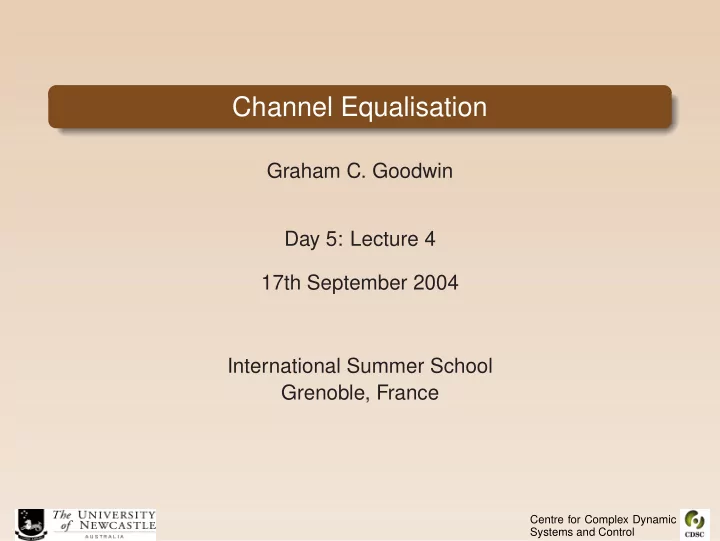

Channel Equalisation Graham C. Goodwin Day 5: Lecture 4 17th September 2004 International Summer School Grenoble, France Centre for Complex Dynamic Systems and Control
Introduction In the previous lecture, we used the Channel Equalisation problem of Telecommunication as a motivating example. Here we further explore this application. Centre for Complex Dynamic Systems and Control
The Problem We transmit data (drawn for a finite alphabet – say ±1) over a communication channel. During transmission, the data is corrupted by (i) dispersion due to the channel (i.e., neighbouring symbols interfer) (ii) noise Centre for Complex Dynamic Systems and Control
Removal of Inter-Symbol Interference in Digital Communications v k noise Digital Received Communications u k y k Data Data Channel = + + + + ν K y g u g u g u − − − − − l l 0 1 1 k k d k d k d k Centre for Complex Dynamic Systems and Control
Express in State Space Form ⎡ ⎤ u − ⎢ ⎥ 1 k u = ⎢ − ⎥ 2 k x M k ⎢ ⎥ u ⎢ ⎥ − − l ⎣ ⎦ k d + = + x Ax Bu 1 k k k = + ν y Cx k k k Centre for Complex Dynamic Systems and Control
⎡ ⎤ ⎡ ⎤ K K 0 0 1 ⎢ ⎥ ⎢ ⎥ 1 0 = = ⎢ ⎥ ⎢ ⎥ ; A B O M ⎢ ⎥ ⎢ ⎥ M 1 0 ⎣ ⎦ ⎣ ⎦ = K K [0 0 ] C g g { 0 l 1 4 24 3 − 1 d + l 1 Problem : Given { y k } – what is { u k } ? Centre for Complex Dynamic Systems and Control
Special feature of our case: u k ∈ Finite Set Use a Rolling Horizon constrained state estimator. Note : Closed Form solutions available as for the control problem – particularly simple for N = 1. Centre for Complex Dynamic Systems and Control
Special Case; N = 1, R → 0 Ω ˆ constrained to (finite alphabet) u = Θ ˆ { } u q − Ω | N d N where ⎡ ⎤ Θ = − − 1 ˆ ˆ K y g u g u ⎢ ⎥ − − − − − − l l 1 1| 1 | 1 N N d N N d N ⎣ ⎦ g 0 This optimal Receding Horizon solution is actually used extensively in practice. (Called Decision Feedback Equalizer ) Centre for Complex Dynamic Systems and Control
Diagrammatic Form 1/g 0 N/L G ′ ( q ) Decision Feedback Equalizer Recall that this circuit was introduced on: Day 1: Lecture 2. We now see that it is a special case of receding horizon finite alphabet estimation. Centre for Complex Dynamic Systems and Control
Example 1 Here we recall the results presented in the second lecture on Day 1. = − + + 1.7 0.72 y u u u n − − 1 2 k k k k k Centre for Complex Dynamic Systems and Control
4 3 2 1 u k u k , ˆ 0 −1 −2 −3 −4 0 5 10 15 20 25 k Figure: Data u k (circle-solid line) and estimate ˆ u k (triangle-solid line) using the DFE. Noise variance: σ 2 = 0 . 1. Centre for Complex Dynamic Systems and Control
4 3 2 1 u k u k , ˆ 0 −1 −2 −3 −4 0 5 10 15 20 25 k Figure: Data u k (circle-solid line) and estimate ˆ u k (triangle-solid line) using the DFE. Noise variance: σ 2 = 0 . 2. Centre for Complex Dynamic Systems and Control
4 3 2 1 u k u k , ˆ 0 −1 −2 −3 −4 0 5 10 15 20 25 k Figure: Data u k (circle-solid line) and estimate ˆ u k (triangle-solid line) using the moving horizon two-step estimator. Noise variance: σ 2 = 0 . 2. Centre for Complex Dynamic Systems and Control
8 Example 2 Consider an FIR channel described by H ( z ) = 1 + 2 z − 1 + 2 z − 2 . (1) Centre for Complex Dynamic Systems and Control
In order to illustrate the performance of the multistep optimal equaliser presented, we carry out simulations of this channel with an input consisting of 10000 independent and equiprobable binary digits drawn from the alphabet U = {− 1 , 1 } . The system is affected by Gaussian noise with different variances. Centre for Complex Dynamic Systems and Control
The following detection architectures are used: direct quantisation of the channel output, decision feedback equalisation and moving horizon estimation, with parameters ( L 1 , L 2 ) = ( 1 , 2 ) and also with ( L 1 , L 2 ) = ( 2 , 3 ) . Centre for Complex Dynamic Systems and Control
0 10 Probability of Symbol Error −1 10 L 1 = 2, L 2 = 3 L 1 = 1, L 2 = 2 DFE Direct Quantization −2 10 −2 0 2 4 6 8 10 12 14 Output Signal to Noise Ratio (dB) Figure: Bit error rates of the communication systems simulated. Centre for Complex Dynamic Systems and Control
9 Conclusions In this lecture we have presented an approach that addresses estimation problems where the decision variables are constrained to belong to a finite alphabet. Centre for Complex Dynamic Systems and Control
Recommend
More recommend